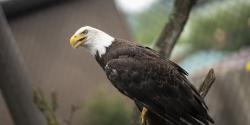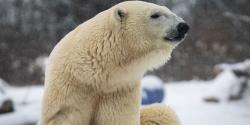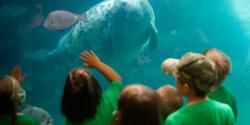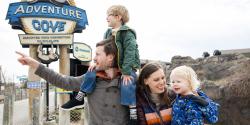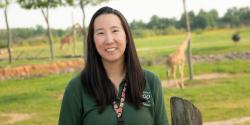Life at the Columbus Zoo and Aquarium is a reflection of life itself, filled with moments of joy, resilience, healing, and, at times, loss.
For nearly a century, your Zoo has been a place where people from all walks of life have come together to connect with wildlife. Accredited and certified by leading organizations—including the Association of Zoos and Aquariums, Zoological Association of America, World Association of Zoos and Aquariums, International Marine Animal Trainers’ Association, Alliance of Marine Mammal Parks & Aquariums, and American Humane—our reputation is built on compassion, expertise, and the dedication of the people who care for the animals who call the Zoo home.
Every day, our Animal Care and Conservation Medicine teams dedicate themselves to nurturing these lives. They are there when new beginnings spark hope, when challenges arise in the middle years, when critical interventions are needed, and when farewells must be said. Through it all, they remain constant, quietly serving as guardians of the circle of life.
New Beginnings: Births That Inspire Hope
Moments that remind us of the power of conservation and the joy of first steps.
The arrival of a new life is always a powerful reminder of why conservation matters. It brings joy, hope, and the reassurance that future generations of endangered animals can still have a chance.

In July 2025, the Columbus Zoo welcomed a baby Asian elephant to first-time mother, Sundara (“Sunny”). This calf already weighs more than 300 pounds and is thriving alongside the herd. The birth is especially meaningful: Asian elephants are endangered, with fewer than 50,000 remaining in their native ranges. Habitat loss and poaching threaten their survival, which makes every calf born a meaningful step toward securing the species’ future.
Bonobo Kibibi, a first-time mom, had already gained some insight into motherhood by watching fellow bonobo, Faith, care for her son, Bob. When Kibibi delivered her own baby boy, she handled labor well, and her maternal instincts surfaced right away. Still, as she tried to settle into her new role, she held her baby too low near her groin, making it impossible for him to nurse. The care team observed closely without intervening at first, but, after 24 hours, they gently stepped in, lightly sedating Kibibi so the newborn could be positioned properly. He latched immediately and nursed successfully, but, when Kibibi woke, she returned to holding him too low. For 10 days, the team provided around-the-clock feedings to help him grow stronger while Kibibi remained nearby, watching from the indoor habitat and spending time with young Bob, which encouraged her instincts even more.
When the time felt right, the team reunited Kibibi with her son. After about two hours of trial and error, she figured out the correct nursing position and he latched on. Because male bonobo infants form especially close bonds with their mothers, this step was critical, and the care team’s gentle guidance allowed Kibibi to learn while still taking the lead. Now, her milk production is steady, her bond with her baby is strong, and both mother and son are continuing to do well together.
Thriving Through Life: Mid-Life Care
Stories of animals who overcome obstacles with the help of dedicated teams.
As animals grow and age, their needs change. Middle age often brings new challenges, and the Columbus Zoo’s teams adjust care plans to help every animal remain healthy and active. With more than 600 species represented here, each with its own median life expectancy and unique needs, providing tailored mid-life care is one of the most important responsibilities we carry.
Sea lions are a perfect example. As they enter their middle years, vision health becomes especially important. Through positive and voluntary training, Zoo teams conduct regular eye exams that allow them to catch early signs of cataracts. This proactive care has already made a tremendous difference.
In 2021, Qizai, known affectionately as “Cheese,” underwent the Zoo’s first-ever cataract surgery for a sea lion. Since then, he has continued to receive follow-up care to manage his vision. Ayla, the Zoo’s oldest female sea lion, also benefited from this focused approach. After successful surgery, she now receives smaller interventions to keep her eyesight strong. These efforts are possible through partnerships, like this one with MedVet, who have specialists in ophthalmology and anesthesiology and work side by side with our teams. Together, they ensure that sea lions like Qizai and Ayla continue to thrive, inspiring guests as advocates for ocean conservation.

Critical Interventions: When Every Second Counts
The urgency and precision of medical care that can make all the difference.
There are moments when an animal’s wellbeing depends on urgent medical intervention. These are the times when quick action, precision, and teamwork truly make the difference between life and loss.

Stubby, a beloved resident manatee, has faced many challenges throughout her life. She cannot be released into her native waters because of serious injuries from a previous boat strike. In addition, she has battled recurring viral dermatitis for years, with her appetite often reduced as a side effect. During her most recent flare earlier in 2025, the teams paused all tours in her area to provide her with a quiet, calm space to heal. She received medication, nutrition through tube feeding, and constant observation until she regained her strength. Once she recovered and the veterinary team cleared her, Stubby returned to her habitat where she resumed her important role as a foster companion for orphaned manatees going through rehabilitation.
Bonobo Bila Isia recently experienced a medical crisis: He began showing signs of lethargy and diarrhea. At first, the team treated him with IV antibiotics, which helped. However, when he started guarding his abdomen and showing signs of pain, the decision was made to bring him to the Columbus Zoo’s customized Animal Hospital, where a CT scan revealed bacterial lesions on his liver. Because Bila is not trained to easily accept oral medication, his care team continues to treat him with IV antibiotics. His condition is being closely monitored, and his progress is assessed daily. Bila’s story highlights the persistence required when every second matters, and when an animal depends entirely on the skill and commitment of the people who care for him.
A Gentle Goodbye: End of Life Care
Compassionate care that honors a lifetime of love and learning.
Every animal at the Columbus Zoo is cherished, and when the time comes to say goodbye, it is done with compassion, respect, and love. End-of-life care is never easy, but it honors the connection shared between animals, staff, and guests.
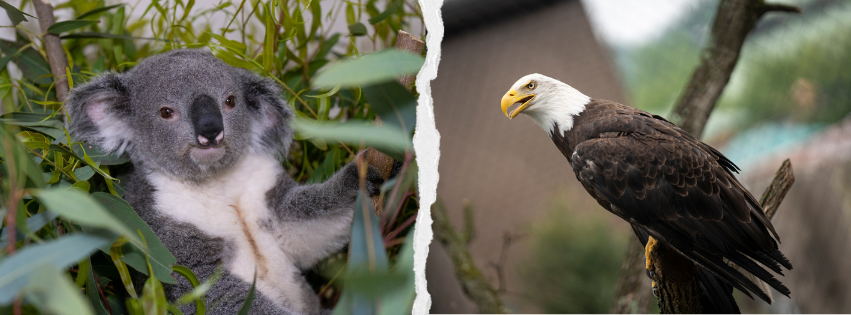
Koala, Koen, was one such animal. Gentle and trusting, he learned to voluntarily take part in his own medical care, even offering his paw for blood collection. When he was diagnosed with lymphoma, a fast-moving cancer, the Zoo team worked with MedVet oncologists to begin chemotherapy…a rarely documented treatment for koalas. The goal was to give him more time, but the disease progressed too quickly. Saying goodbye was painful, yet Koen’s legacy lives on. The training methods developed with him are now being used to help other koalas, including those previously thought too difficult to train, like longtime resident koala, Katy. His memory remains a reminder of how kindness, trust, and innovation can leave a lasting mark.
Cheyenne, a bald eagle, lived to age 21, far beyond the typical lifespan of her species. She was rescued from the wild with injuries that made her non-releasable, but at the Columbus Zoo, she built a remarkable bond with her care team. That trust allowed the team to treat her for both arthritis and heart disease well into her senior years. When her quality of life recently declined, humane euthanasia was chosen. Cheyenne was the only wild-born bald eagle trained at the Zoo, and her story is one of resilience and partnership that extended her life by many years.

Vera, an 8-year-old tiger, recently faced a sudden and devastating illness. After showing signs of lethargy and discharge from her eyes, she was diagnosed with pneumonia caused by an environmental fungus. Despite aggressive antifungal treatment, the illness proved too severe, and Vera passed away. This type of fungus can remain dormant for years and is not contagious. Though her time here was brief, Vera was deeply loved by her team. Her passing serves as a reminder of the unpredictability of life, and of the devotion shown by staff who cared for her until the very end.
When Cori, a 9-year-old Matschie’s tree kangaroo, began showing subtle changes in his routine, his care team quickly noticed. Keepers are attuned to even the smallest differences that could signal health concerns, so Dr. Priya was called to check on him. Later that same day, Cori underwent an immobilization so our veterinary team could better understand what was happening. With Dr. Hostnik, a radiologist and associate professor at The Ohio State University College of Veterinary Medicine, onsite, Cori received advanced diagnostics including ultrasound and CT imaging. These scans revealed lesions on his lungs. Despite every effort and the best medical support available, Cori’s condition declined over the following days, and he passed peacefully in the early morning hours.
Cori held a special place within the Matschie’s Tree Kangaroo Species Survival Plan (SSP) because he was not yet genetically represented. Our team had been hopeful that he and his mate, Luka, would produce offspring that could strengthen this endangered population. Native to the rainforests of Papua New Guinea, Matschie’s tree kangaroos face significant threats in the wild, making every individual critical. Through close collaboration with the SSP and the Tree Kangaroo SAFE program, the Columbus Zoo continues to support conservation and research efforts for these remarkable animals, ensuring Cori’s legacy contributes to the future of his species.
Extending Years, Deepening Impact
Across the Zoo, many animals surpass the median life expectancies of their wild counterparts. They do so because of the commitment of the people who care for them every day, and they serve as ambassadors who teach us about their species and inspire us to protect wildlife everywhere. With such a large and diverse population, it’s natural that some animals will face age-related challenges or health issues at different times. While it can sometimes feel like these losses occur close together, each situation is unique. What remains constant is the important role each animal plays as an ambassador—teaching us about their species and inspiring us to protect wildlife everywhere.
The Journey We Share
Life at the Zoo is about the deep commitment to each animal’s wellbeing. From the moment they arrive to the moment they leave us, our teams are there with expert care, steady dedication, and hearts full of love. In many ways, this reflects the cycles we all know in our own lives, such as raising a puppy, watching a child grow, or caring for an aging parent. Just as families celebrate milestones, face challenges, and provide comfort, our animal care teams are alongside these animals through every stage of life.
The Columbus Zoo is a place where guests can see these life cycles unfold and recognize familiar emotions of joy, pride, and even loss. By sharing in these moments, you become part of a larger family that honors the dignity of every life. Thank you for standing with us. Your visits and compassion make it possible for us to provide this level of care and to celebrate the lives entrusted to us.
We invite you to learn more about the animals who call the Zoo home.



